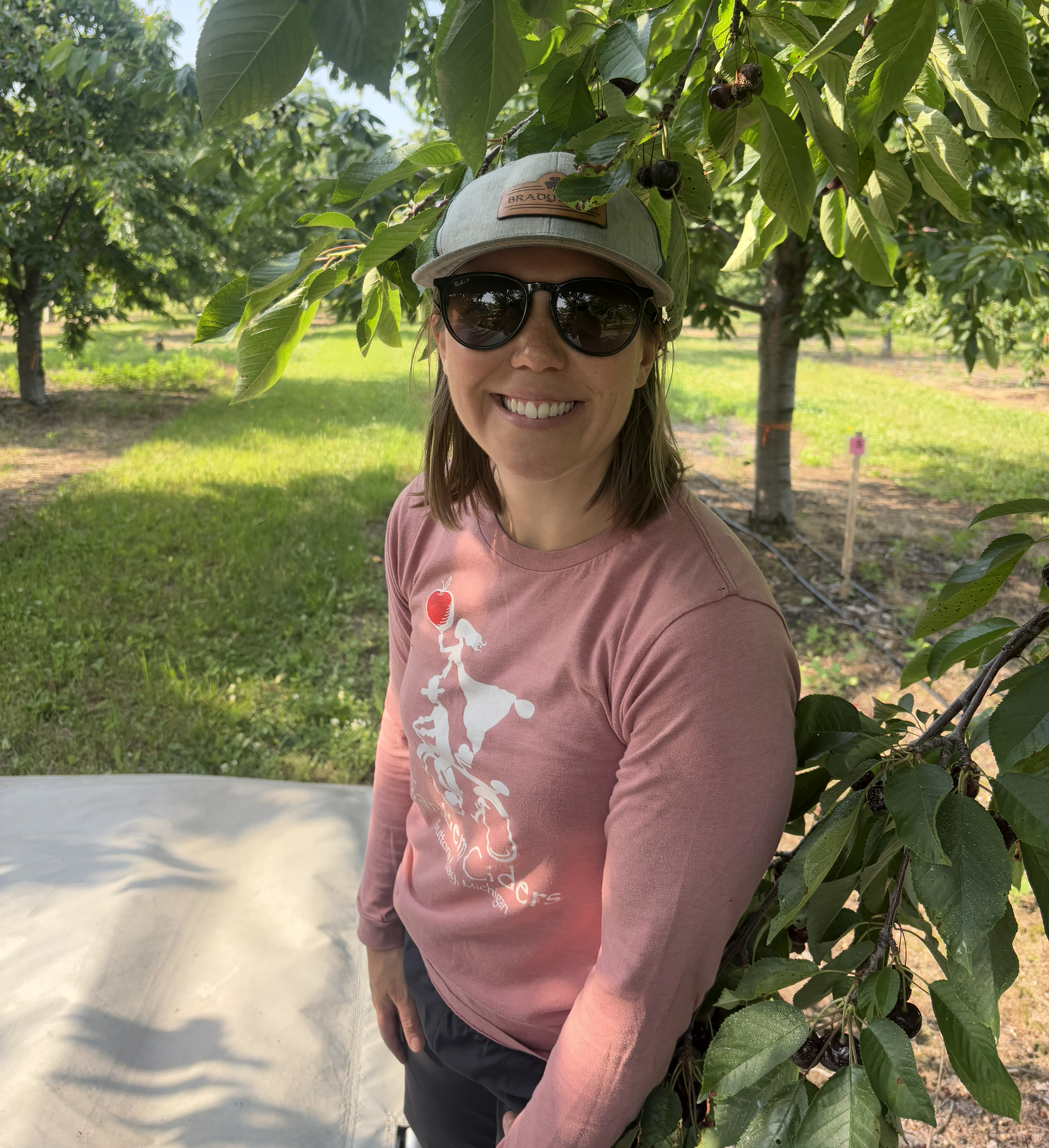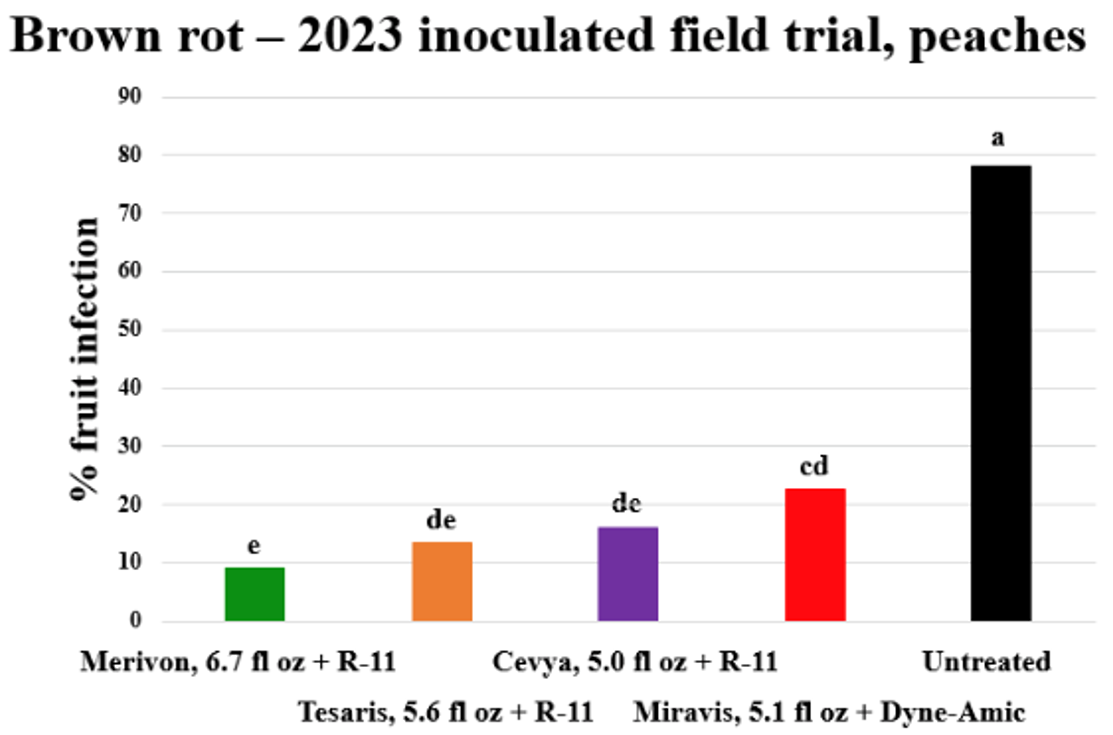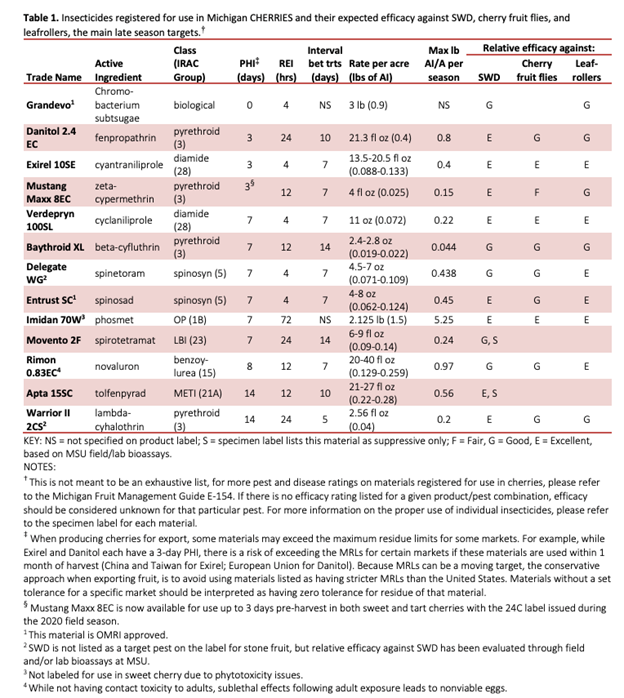Northwest Michigan fruit update – July 15, 2025
Growers are harvesting sweet and tart cherries. There is significant pressure from American brown rot and spotted wing drosophila with the warm and humid conditions.

Weather report
The weather continues to be hot and muggy. Today, July 15, is forecasted to be 90 degrees Fahrenheit. Temperatures will cool on Wednesday and Thursday, but there is about a 35% chance of rain on both days. Friday is predicted to be sunny and in the mid-70s. More rain could hit the area a week from today. In addition to the potential rainfall, relative humidity continues to be high in the mid 70% to highs in 80%. These conditions are putting pressure on growers to adequately manage brown rot and spotted wind drosophila.
We had more rainfall on Sunday, July 12. The Northwest Michigan Horticulture Research Center received 2.67 inches of rain. The rain must have come quite fast as our farm roads are washed out worse than I have ever seen them in the past. The rainfall was variable across the region as it has been all season-long. For the east side of the area, Eastport received 2.7 inches, Kewadin received 0.96 inches, Elk Rapids received 1.3 inches and Williamsburg received 1 inch. Old Mission Peninsula’s Enviroweather station recorded 2.67 inches—the same as the station’s rainfall amount. East Leland only received 0.75 inches, Northport received 0.49 inches, and Benzonia and Onekama received just about 0.75 inches of rain on July 12.
Our growing degree day (GDD) averages are so close to the 35-year average. For 2025 at the Northwest Michigan Horticulture Research Center, we have accumulated 1750.8 GDD base 42 and 1,092 GDD base 50. We are almost spot on to 35-year average this week: 1,746 GDD base 42 and 1,083 GDD base 50.
Crop report
Sweet cherry harvest is in full swing in northwest Michigan. Many growers are working hard to get the fruit off the trees with the heat and humidity. Growers seem to be jumping around a bit more than usual this year, likely the result of the crop size in individual blocks and with disease and insect pressure. We harvested Benton sweet cherries for an Accede trial yesterday, and we are starting hand harvesting of Black Pearl today. Some growers have also begun tart cherry harvest this week. There is a light crop of tarts in many blocks, so the fruit is red and ready to go. We harvested tart cherries yesterday, July 14, in our all-purpose Montmorency block. Again, growers are going to move through harvest as fast as possible.

Disease report
Apple scab. According to the Enviroweather scab model, we are at 100% mature spores and 99% dispersed spores. They have called the end to primary scab in southwest Michigan and on the Ridge. West central Michigan has not called the end to primary scab because they have not had daytime rains. We have also called the end of primary scab here in northwest Michigan. Some growers have reported scab as a problem in particular blocks.
Here are the following links for RIMpro outputs from July 15, 2025:
Cherry leaf spot. We have substantial leaf spot in our untreated checks in the efficacy trial. Today, we are rating our efficacy trial with Michigan State University Extension specialist and professor George Sundin and his crew. We are also working on a burn-out trial with plated cherry leaf spot. We hope to have good results to share with growers this winter. With all the disease pressure this season, we recommend using a post-harvest spray for continued protection against the leaf spot pathogen. Chlorothalonil or captan are good choices for post-harvest control. If you have used a lot of captan this season, watch out for the maximum use per season, which is 17.5 pounds. You may need a second postharvest application if the season continues to be wet and warm. Keep leaves on the trees through September if possible.
American brown rot. We have significant American brown rot infections in sweet cherries at the research station. Compared with last week, I have had an increased number of calls about American brown rot control and what growers can do to stop this disease. As we are witnessing at the station, American brown rot control in sweet cherry is critical as this disease can go from a few infected fruit to an epidemic level in less than 24 hours. In most blocks, we will not harvest sweet cherries due to the levels of infection.
We have had ideal weather for American brown rot as this disease is favored by warm and wet conditions, both of which we have had in the past few weeks. Tighten up your intervals if American brown rot infection is present in the orchard. Luna Sensation, Merivon, Tesaris, Miravis and Cevya are all labeled good to excellent for American brown rot control. As sweet cherries are ripening, the sugar content in the fruit is high and the fungus needs sugars to grow.
Additionally, we have seen bird pecks in fruit, and these areas of damage are excellent ways for American brown rot to get a foothold on infection. Lastly, we have seen spotted wing drosophila stings in fruit, and these oviposition or exit holes are another way American brown rot can more easily infect fruit.
Because of the American brown rot pressure, we have had many questions about fungicide resistance in the American brown rot pathogen. Sundin’s group has been screening for potential resistance for the past few seasons, and we are not finding resistance in our single site fungicides (Luna Sensation, Merivon, Tesaris, Miravis and Cevya). The main takeaways from this resistance screening is that we have widespread resistance to Indar, and growers should not have been using Indar at all for American brown rot control. The SDHIs are still OK with sensitivity, and they are good to use, but we recommend adding another material for resistance management.
Use the maximum rates of the SDHIs. Cevya is also a good fungicide for American brown rot control, and it will control Indar-resistant fungus. Again, the data shows that the fungicides are still working to control American brown rot, but the pressure from infection is so great with the warm and humid conditions (Figure 1).

Pest report
Codling moth. We caught an average of two moths per trap. Codling moth has been caught at the Northwest Michigan Horticulture Research Center for five weeks in a row, and we set our biofix for June 3. Based on the codling moth model and the June 3 biofix date, second generation egglaying should begin July 19.
Spotted wing drosophila. This is the pest of concern for growers right now. Like fungal diseases, this pest thrives when it is warm and wet, and we have had no shortage of these conditions this season. Therefore, the pressure from spotted wing drosophila is intense right now. Trap counts are not important as the fruit is ripe, and female flies will prefer to go to fruit for oviposition rather than be attracted to the spotted wing drosophila trap. So, growers can stop trapping and really concentrate on shortening intervals and using materials rated excellent to control this pest. The following video shows how to test fruit for spotted wing drosophila larvae.
We have seen new stings and exit holes in fruit, meaning this pest has been around for at least two weeks. Once the population of spotted wing drosophila rises exponentially, it is hard to stop these insects because there are just so many. We are in that situation now, and the populations are extremely high at the research station—in many blocks, we can already smell the spotted wing drosophila infestation.
Protect both sweet and tart cherries from spotted wing drosophila infestation. With the shortage of fruit in the orchard, you will need to protect what is left from infestation; with a light crop, the spotted wing drosophila pressure will increase. “Managing Spotted Wing Drosophila in Michigan Cherry” from Michigan State University Extension is a good resource on spotted wing drosophila management. Be diligent about keeping spray intervals tight to prevent infestation before harvest (Figure 2).




 Print
Print Email
Email
